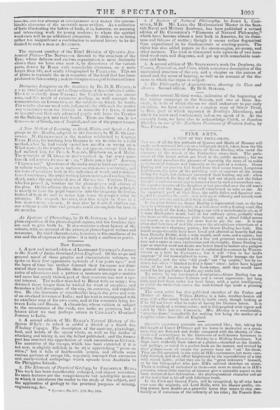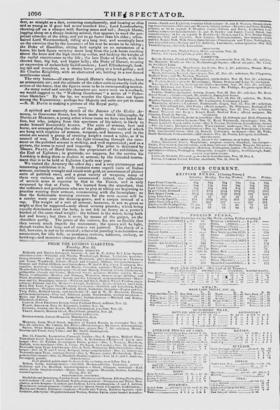GRANT'S equestrian portraits are accounted like ; but, taking his full-lei:0i
of Count D'ORSAY and his horse in mezzotint as a sped- men, they are flattered and feeble compared with the identity of cha- racter and resemblimee in the likenesses of well-known horsemen in Rotten Row, called Equestrian Sketches by a Walhing Gentleman. Yet these have evidently been taken at a glance—sketched on the thumb. mid perhaps, or noted in a pocket-book on the instant, and revised by after glimpses—ai all events the persons have not "sat" for them. They are lithographed, in the style of HIrs caricatures, but more care- fully finished, and their effect heightened by the superaddition of's tint with raised lights: either they are by the "great unknown" himself, or by the lithographer who puts HB's satirical sketches on stone. There is nothing of caricature in them—not even so much as in HB's portraits, where little touches of humour give a quizzable aspect to the most matter-offiwt delineation : the physiognomical character and air of the individual is hit off with felicitous truth.
In the First and Second Parts, will be recognized, by all who have ever seen the originals, old Lord Rolle, with his Macaw profile, sit- ting almost bent double on a powerful horse that seems to step cau- tiously as if conscious of the infirmity of his rider; Sir Francis Bur- den, as straight as a dart, cantering complacently, and lousing as slim and as young as if gout had never touched him ; Lord Londonderry, showing-off on a charger with flowing mane and tail ; Joseph Hume, jogging along on a sleepy-looking animal, that appears to need the per- petual stimulus of the whip, and yet to go faster than his rider ; white. haired Lord Westmoreland, riding at a long trot, and seemingly bent on the exercise that by the looseness of his scat he seems to be taking ; the Duke of Hamilton, sitting bolt upright on an automaton of a horse, his lank figure seeming more long from the jack-boots reaching above the knee and the high stand-up collar, and looking the knight of the rueful countenance to the life ; the late Duke of Leeds, with his shrewd face, big hat, and bigger belly ; the Duke of Dorset, wearing an expression of melancholy fastidiousness; Lord Ellenborough, look- ing tall and truculent, on a showy horse going at a hand-gallop; arid Sir Charles Knightley, with an abstracted air, holding in a raw.botied mettlesome steed.
The very horses-all except Joseph Hume's sleepy hackney-have an aristocratic air ; and the attitude of the riders suits so exactly with the action of the horse, that the figures seem to be in corresponding motion.
As many noted and notable characters are never seen on horseback, we would suggest to the "Walking Gentleman" a series of " Pedes- trian Sketches." By the by, we wonder the Queen does not figure among the Equestrians : perhaps her Majesty and suite are yet to come R. B. Davis is making a picture of the Royal party.



























 Previous page
Previous page